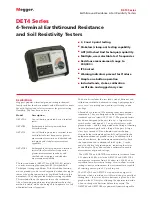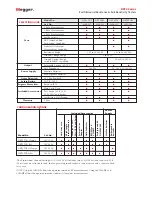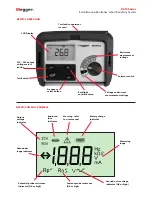
ART (ATTACHED ROD TECHNIQUE)
TESTING CAPABILITY
The DET4TC2 and DET4TCR2 include the additional
testing capability that we have termed
ART
, for
Attached
Rod Technique
. A nagging problem with traditional
ground testing has been the requirement to “lift” (i.e.,
disconnect) the utility connection. Once the grounding
conductor (the main conductor that connects the facility
to the ground rod or grid) has been attached to the
grounding electrode, the utility ground becomes a parallel
resistance. The utility neutral is typically bonded to the
ground bus at the service entrance and this connection,
during a ground test, causes test current to flow back
through the utility ground as well as through the test
electrode. Test current divides according to Law of Parallel
Resistance, but the tester makes its measurement based on
total current flow. The reading is the combined parallel
resistance of the on-site ground and the utility protection.
This is a valid measurement, but not of the test electrode
exclusively.
This poses a considerable problem in many common
testing situations. If a commissioning test were required to
determine if design specifications had been met for a new
facility, such a reading would be insufficient. Lightning
protection requiring a short, straight path into the earth,
could also not be properly validated. But lifting the utility
connection poses several problems, not the least of which
is the breaking of what is often a welded bond, in addition
to the temporary loss of protection.
Clamp-on ground testers, which measure ground
resistance by clamping around the rod and inducing a
test current onto it, are only a limited solution. They can
accurately measure resistance of a single rod in a parallel
system by inducing the test current onto the clamped
rod and utilizing all the parallel grounds as the return.
Collectively, these returns, typically the multiple grounds
of the utility, contribute little to the loop measurement.
This is essentially the reverse of the operation of a
traditional tester, which uses the current probe as
the return while current “goes to ground” through all
parallels collectively. This technique solves the problem
of separately measuring an attached rod, but leaves the
problem that it cannot be proven.
A clamp-on measurement has to be accepted on faith
and its reliability is based squarely on the knowledge
and experience of the operator, leaving a large margin
for “human error.” In complex, multiply connected grids
and other grounding schemes, return paths may exist
that are entirely metallic, not including earth at all. The
clamp-on test current will circulate through such paths
and give a reading, essentially a continuity reading of the
grid structure having nothing to do with soil resistance.
Such readings will be low, and appear to the uninformed
as acceptable grounds. The responsibility for making
these determinations falls squarely on the operator.
But even when properly addressed, there is no way of
demonstrating the competence of the readings to a third
party, such as a client. They must simply be accepted.
The
ART
testing capability combines the advantages of
both of these technologies to produce a method that
can reliably measure an attached ground, and prove
it! A built-in clamp input, used in conjunction with the
optional ICLAMP accessory, connected below the point of
separation of the parallel test currents, measures only the
current flowing through the test ground, not that going
back through the utility. This current value is then used by
the microprocessor to calculate ground resistance, strictly
in accordance with
Fall of Potential
or its derivative
procedures, supported by IEEE Standard 81 for proper
ground testing, and subject to the appropriate proofs.
The
ART
method
employs leads and probes just as does
any traditional tester. Ground resistance can be profiled
and graphed by moving the potential probe against the
position of the current probe, and a Fall of Potential graph,
Slope Method mathematical proof, or any of the other
proven methods utilized to demonstrate the accuracy of
the test. The only thing different from the operation of a
familiar, traditional ground tester is that the clamp permits
separation of the test currents in an attached or otherwise
parallel-grounded system. This technique enables local
grounds to be tested without lifting the utility connection,
yet with the ease, reliability and confidence of a separate
commissioning test.
Current measuring clamp (inset)
for ART testing capability
DET4 Series
Earth/Ground Resistance & Soil Resistivity Testers


























